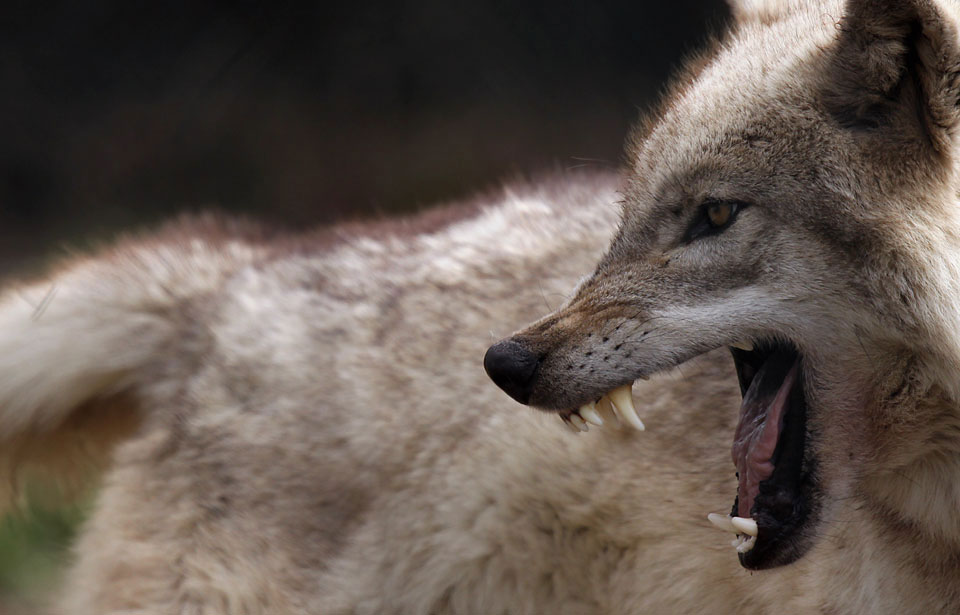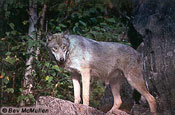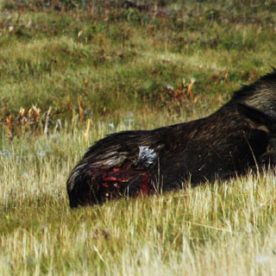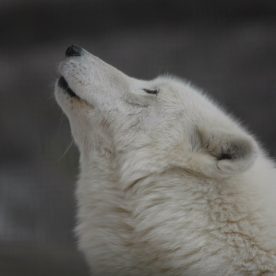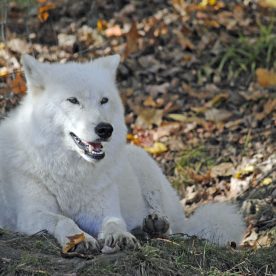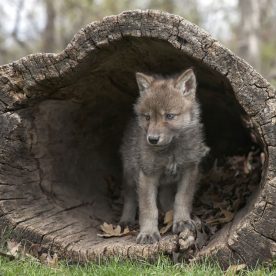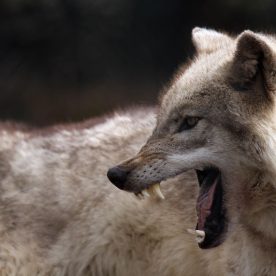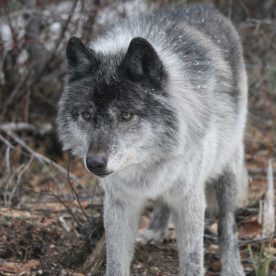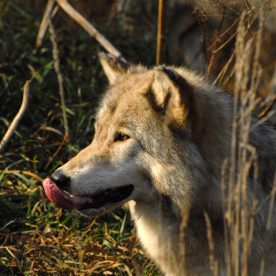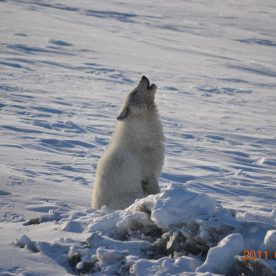Description
It is virtually impossible to describe the typical appearance of the wolf Canis lupus. Wolves of many large arctic islands and Greenland usually appear snow-white from a distance, but closer up often reveal grey, black, or reddish shades. Wolves of northern North America and Eurasia vary in colour. A single pack may contain animals that are black, shades of grey-brown, and white. Wolves in the heavily forested areas of eastern North America are more uniform in colour. They are often a grizzled grey-brown, similar to some German shepherd dogs.
This colour variation is a good example of natural selection, a process that enables those animals best suited to a particular environment to survive. On the arctic islands, where much of the ground is snow-covered for at least nine months of the year, being white is a distinct advantage, so wolves in the Arctic may be nearly white. In the mottled grey, green, and brown world of the eastern forests the normal coat of the wolf is an effective camouflage. As a wolf moves stealthily, or rests, it blends into the background and is hardly seen.
Wolves in the Arctic have extremely dense underfur, which insulates them against rigorous winters. Another adaptation to environment is their habit of hunting in packs, or groups, which enables them to kill large animals, such as deer, elk, moose, caribou, bison, and muskox.
Signs and sounds
The howling of a wolf pack is one of the most awe-inspiring wilderness sounds. It is a form of communication among wolf packs.
Wolves often howl spontaneously at a rendezvous site, or place where the pack meets. This howling may be a form of “song-fest,” for the wolves apparently enjoy it. In one instance, a pack of arctic wolves separated from some pups by a fast-flowing river howled frequently for several hours. As they did so, the pups moved anxiously along the river bank. This howling seemed to be a form of calling or coaxing. Howling by a pack may also be a way of warning other packs to keep away from occupied territory and may serve to separate packs.
Habitat and Habits
Wolves are territorial. Each pack occupies an area that it will defend against intruders. Sizes of territories vary greatly and are dependent on the kind and abundance of prey available. When neighbouring packs trespass into each other’s territories, fights often ensue that frequently result in the death of pack members. Subordinate wolves in the hierarchy are often forced out of the packs. When this happens, the lone wolves may find mates, then search for unoccupied areas where they can establish new packs.
The wolves’ habit of hunting in packs has resulted in the development of complex patterns of social behaviour. Wolves are social animals: they not only hunt in packs or groups but live most of their lives with other wolves. Studies in Alaska, Minnesota, Michigan (Isle Royale), and parts of Canada (Algonquin Provincial Park and Jasper, Banff, and Wood Buffalo national parks) show that a family made up of male, female, and pups is the basic pack unit. Other adults are pups of previous years or, more rarely, adults from other packs. Adolescent wolves have been learning to hunt for at least a year, so can probably hunt big game animals, wolves’ usual prey, with the rest of the pack.
Studies of wolf packs in captivity show a highly organized social structure centring on a dominant male and a dominant female. A dominant wolf holds its tail high, stands stiff-legged, and bristles its mane. In its presence, a subservient animal cowers on the ground with its ears back or stands with its tail between its legs, maintaining a slinking posture.
The pack bond is strongest during winter, when the wolves travel and hunt together. In summer, when the pups are young, the adults seldom go on long forays. They may hunt together occasionally after meeting at the den or home site where the pups are being cared for.
Unique characteristics
The wolf was once a much maligned animal. In the western world, people feared and hated wolves, and this legacy is reflected in stories such as Little Red Riding Hood and The Boy Who Cried Wolf. In these popular children’s tales the wolf is made out to be a marauder and a killer of livestock and people.
There is some basis for The Boy Who Cried Wolf, for wolves have killed cattle and sheep. But what of Little Red Riding Hood? There are no records of wolves killing humans in Canada or the United States. Yet, when wolves were spotted near rural communities, fear used to grip the residents. Over time this has become less prevalent. Today, many people know that scientists studying wolves have lived very close to dens where there were pups without being attacked. They have even taken pups from a den without being molested. The parents have usually run away, returning later only to take their young to a more private den or to a rendezvous site.
In areas where wolves are hunted or trapped they fear people and are very wary. However, in remote places, such as in the Canadian Arctic, they show little fear and will often allow people to live near them.
Range
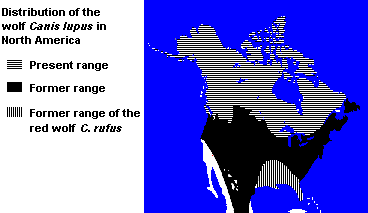 Two hundred years ago wolves, also known as grey wolves, were more widely distributed than any other mammal of historic times. They lived in large areas of North America, Europe, and Asia; the only places they could not occupy were deserts, tropical rain forests, and peaks of the highest mountain ranges.
Two hundred years ago wolves, also known as grey wolves, were more widely distributed than any other mammal of historic times. They lived in large areas of North America, Europe, and Asia; the only places they could not occupy were deserts, tropical rain forests, and peaks of the highest mountain ranges.
Wolves still live in large areas of the Northern Hemisphere; however, their primitive range has been greatly reduced due to changes in the landscape and people’s efforts to exterminate them.
In North America, wolves have been exterminated in the Atlantic provinces, Mexico, the United States (except Minnesota, Alaska, and some of the western states), and the heavily populated areas of southern Canada. They are still common in lightly settled portions of Canada from Labrador to British Columbia and in the Yukon Territory and the Northwest Territories.
The red wolf C. rufus was once common in the southeastern United States. It has been eliminated in the wild. However, through a captive breeding program, the species is being reintroduced into its former range.
Feeding
Wolves’ chief prey are large mammals such as deer, moose, caribou, elk, bison, and muskox. Wolves also eat a variety of smaller mammals and birds, but these rarely make up more than a small part of their diet.
Wolves work hard for their food. They have to. Studies show that they kill only about one large mammal for every 10 chased. In winter, they usually kill old or young animals when these are available, but when prey numbers decline wolves prey on all age groups, and it may take the entire pack to bring an animal down. In summer, much of the wolves’ diet consists of young animals born that year, because they are easiest to catch.
In winter, scientists can study the hunting behaviour of wolves from aircraft, using radio transmitters, or by following their tracks in the snow. More recently, scientists have used collars that monitor movements by satellite technology.
Opportunities for watching summer hunts are rare, so much less is known about hunting habits in this season. Because wolves usually travel alone or in pairs in summer, much of the hunting may be of a different nature. Stealthy stalking may play a large part in summertime hunting, according to one scientist who has studied wolves intensively.
Breeding
Wolves differ from domestic dogs in their reproductive cycles. Male dogs can breed at any time of year and females every six months, whereas both male and female wolves in the wild can breed only once a year. In captivity, male wolves can successfully breed with more than one female. Breeding time varies with the latitude but most commonly occurs in March and April. After a nine-week gestation, or pregnancy, period, litters of five or six pups (sometimes eight or more) are born.
Wolves usually reach sexual maturity in their second year. It is possible for younger animals to have pups, but this is not normally the case. A pack may include several mature females that can produce pups.
Wolf pups are usually born in a den. In coniferous forests and on tundra this den is commonly dug in a type of soil that lends itself to digging, such as in an esker, or gravel ridge caused by glacial meltwater, or similar area. In mixed forest areas the den may be located in an old pine stump or rock crevice. The pack usually remains at the whelping, or birthing, den for a month or more unless it is disturbed.
The pups remain inside whelping dens for approximately two weeks. When they begin to move around outside, another member of the pack may sometimes babysit while the parents go hunting. Occasionally, the pups are left alone for a day or longer at a time. By mid-autumn they are travelling with the pack and participating in hunting and other pack activities.
Frequent play helps young wolves develop hunting skills. Mature wolves can set up ambushes or drive prey toward other wolves. These learned, or non-instinctive, skills originated in their clumsy attempts as pups to hide behind obstacles and then jump out at each other. Even in winter, after they are almost fully grown, pups continue to play in a variety of ways, such as chasing around a tree in a forest opening or having a fast-moving game on a wilderness lake with a piece of wood or garbage as the prize.
Conservation
People have long practised population control and extermination of wolves. At times, governments have paid a sum of money, called a bounty, for each animal killed. In Canada, the first bounty payment was made in Ontario (then Upper Canada) in 1792. Eventually bounties were paid in every province and territory inhabited by wolves, but by 1973 they had been discontinued at the provincial and territorial level, except in the Northwest Territories. When Ontario repealed the wolf bounty in November 1972, it was replaced by the Wolf Damage to Livestock Compensation Act, which makes cash payments to farmers whose livestock is damaged by wolves or coyotes. In Quebec, bounties are occasionally offered by certain municipalities; however, since 1984 trapping and hunting of wolves is only allowed during part of the year. British Columbia and the prairie provinces now use traps and poisons to kill wolves inhabiting areas where they may threaten livestock or game populations.
Wolves prey on big game animals and help to control their populations. Where wolves are absent (for example, Anticosti Island, Pennsylvania, and Wisconsin), white-tailed deer have overpopulated their ranges and damaged forests. Food shortages and mass starvation of deer during the winter sometimes follow. Where wolves remain, hunting by humans and easier access to big game in wilderness areas has led to increasing competition between people and wolves for game animals, as elk, moose, deer, and caribou numbers decline.
Wolves have already been exterminated in many places. However, there may be less danger of such excesses in the future, as wolf control is increasingly based on biology rather than emotion. There is now a greater awareness among hunters and others that the killing by wolves of deer and other prey species, which we may want for ourselves, is not a sufficient reason for the extermination of wolves. Sometimes populations of game animals are critically low, so on biological grounds wolf control could be justified; however, control programs are always opposed by ever-increasing urban populations. Proposed wolf culls have become major political issues in many areas in North America. When controls are carried out, they need to be done to meet certain criteria, which are based on sound scientific information and stewardship of wildlife populations.
In wilderness ecology, wolves play an important role. And from a human point of view, the great interest and value of having this intelligent animal as part of our wilderness heritage should be sufficient justification for allowing it to survive in a wide variety of wilderness and semi-wilderness areas of Canada.
Resources
Print resources
Carbyn, L.N., editor. 1983. Wolves in Canada and Alaska: their status, biology, and management. Proceedings of a wolf symposium held in Edmonton, May 1981. Report Series No. 45. Canadian Wildlife Service, Ottawa.
Carbyn, L.N. 1987. Gray wolf and red wolf. In M. Novak, J.A. Baker, M.E. Obbard, and B. Malloch, editors. Wild furbearer management and conservation in North America. Ontario Ministry of Natural Resources, Toronto.
Harrington, F., and P. Paquet, editors. 1982. Wolves of the world: perspectives of behavior, ecology and conservation. Proceedings of a wolf symposium held in Portland, Oregon, August 1979. Noyes Publications, Park Ridge, New Jersey.
Mech, L.D. 1970. The wolf: the ecology and behavior of an endangered species. The Natural History Press, New York.
Murie, A. 1944. The wolves of Mount McKinley. Fauna Series No. 5. U.S. National Parks Service, Washington, D.C.
Peterson, R.O. 1977. Wolf ecology and prey relationships on Isle Royale. Fauna Series No. 11. U.S. National Parks Service, Washington, D.C.
Rutter, R.J., and D.H. Pimlott. 1968. The world of the wolf. Lippincott, New York.
© Her Majesty the Queen in Right of Canada, represented by the Minister of the Environment, 1973, 1984, 1988, 1993. All rights reserved.
Catalogue number CW69-4/19-1993E
ISBN 0-662-21021-2
Text: D.H. Pimlott
Revision: L. Carbyn, 1993
Photo: Bev McMullen



